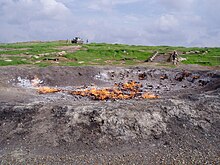Baba Gurgur (Arabic: بابا كركر, Kurdish: بابە گوڕگوڕ ,Babagurgur[1][2]) is an oil field and gas flame near the city of Kirkuk, which was the first to be discovered in Northern Iraq in 1927.
| Baba Gurgur | |
|---|---|
 The Eternal Fire at Baba Gurgur | |
| Country | |
| Coordinates | 35°31′58″N 44°20′09″E / 35.5329°N 44.3357°E |
| Operator | Iraq Petroleum Company |
| Field history | |
| Discovery | 1927 |
It was considered the largest oil field in the world until the discovery of the Ghawar field in Saudi Arabia in 1948. Baba Gurgur is 16 kilometres north-west of Arrapha and is famous for its Eternal Fire (Arabic: النار الازلية) at the middle of its oil fields.
Background
editThe name Baba Gurgur is derived from (possibly) Bab or Baba (/bæbʌ/; a Kurdish/Indo-European word for "father") and Gur (/gʊr/; a Kurdish word for "fire; flame; haste"),[3] 'father of fires', or 'the father of underground rumblings'.[4][5]
Morton cites the local belief that the Eternal Fire was the burning fiery furnace mentioned in Chapter 3 of the Book of Daniel, into which King Nebuchadnezzar cast three Jews. Morton further mentions that according to Plutarch, this is where Alexander the Great witnessed "fire issues in a continuous stream, like a spring of water, out of a cleft in the earth," and was used to illuminate the streets.[4][6][7]
The site has a significant importance to Iraqi history, and religious ceremony, visited by women seeking blessing. Conversely, local shepherds used the nearby mud to protect their flocks. The burning flames are the result of an emission of natural gas through cracks in the Baba Gurgur area's rocks.[8][9]
Based on the recommendation of E. Wesley Shaw and Arthur Noble, Turkish Petroleum Company (TPC) geologists, four wells were drilled in northern Iraq. The objective was the "Main" limestone, equivalent Asmari Formation, below the Middle Miocene Middle Fars Formation. The first well was spudded on 5 April 1927 at Pulkhana, followed by those at Injana, Khasm al Ahmar, and finally Baba Gurgur on 30 June. On 23 September, TPC chief geologist Louis "Chick" Fowle noted the Baba Gurgur had already reached the "Main" limestone at 1,521 feet (464 m). Since the well only had casing to 590 feet (180 m), he ordered drilling to be stopped, while casing was extended another 1,000 feet (300 m).[4][5]
Oil strike
editOn 14 October, drilling resumed. At 3 a.m. on 15 October 1927, oil was struck and a great fountain spurted over the crown of the derrick to a height of 42 metres. The oil overflowed into the desert, threatening the nearby inhabitants, their property, and their water supply. Kirkuk and surrounding villages were in danger of drowning in a sea of oil, if the well could not be controlled. Earthen dams, 1.5 km apart, were needed in the wadi, and a depression 24 kilometres away, formed into a temporary catchment pond. Soon, an estimated 2,000 men from the Jubur tribe along the Zab River, and the Obaid tribe on the Hawija plain, were at work. Dangers persisted, as a blue mist of gas would form at night in shallow depressions, posing the risk of poisoning the workers, five of whom were killed. Additionally, the risk of fire was great. As the cloud of oil drifted away from the well site, work could commence on trying to close the control valve. After ten days, and 95,000 barrels of oil, the well was contained.[4][5][10]
Aftermath
editIraq Petroleum Company replaced the TPC in October 1928, as development commenced to produce the Kirkuk Field. Supporting infrastructure included two pipelines to carry the oil to the Mediterranean coast, 100 wells, 12 pumping stations, oil terminals for ships, telegraph and telephone lines, air transport, rail transport, workshops and offices.[4]
In 2018, it was alleged that oil from Kurdish controlled Baba Gurgur went to the Turkish town of Ceyhan, and from there was secretly shipped to Israel.[11]
See also
edit- Iraq Petroleum Company NOC – North Oil Company
- Darvaza gas crater – another natural perpetual flame in Turkmenistan
- Centralia mine fire
- New Straitsville mine fire
- Natural fueled eternal flames
References
edit- ^ "Ev du meh in hinartina petrolê bi rêya boriya Kerkûk-Ceyhanê sekiniye". Rûda. May 6, 2014. Retrieved December 21, 2019.
- ^ "مانا و ئێتمۆلۆژی وشەی کەرکوک". Peyserpress (in Kurdish). Retrieved December 21, 2019.
- ^ Hahzhār (Sharafkandī Abdulrahman) (1997) [1376]. Hihnabanah borīnah: Farhang-i Kurdi-Farsī: Kurdish-Persian (Chāp-i 2 ed.). Tihrān: Surūsh. ISBN 9644350022. OCLC 49060199.
- ^ a b c d e Morton, Michael (2006). In the Heart of the Desert, The Story of an Exploration Geologist and the Search for Oil in the Middle East. Aylesford: Green Mountain Press. pp. 7–11. ISBN 9780955221200.
- ^ a b c Morton, Michael (2014). "A Gusher at Baba Gurgur". AAPG Explorer. AAPG. Retrieved October 11, 2020.
- ^ Yergin, Daniel (January 15, 1991). The Prize: The Epic Quest for Oil, Money, and Power. United States: Simon & Schuster. p. 204. ISBN 0-671-79932-0.
- ^ Plutarch (2001). Plutarch's Lives, Volume II. New York: The Modern Library. p. 168. ISBN 0375756779.
- ^ "Petroleum Sector in Iraq". Republic of Iraq, Ministry of Oil. Retrieved October 11, 2020.
- ^ "ئاراس - كركوك في العصور القديمة". www.koord.com.
- ^ "Report III of the Federal Oil Conservation Board". January 1928: 149. Retrieved October 15, 2015.
{{cite journal}}: Cite journal requires|journal=(help) - ^ "Haaretz.Com". April 11, 2018. Archived from the original on April 11, 2018.
